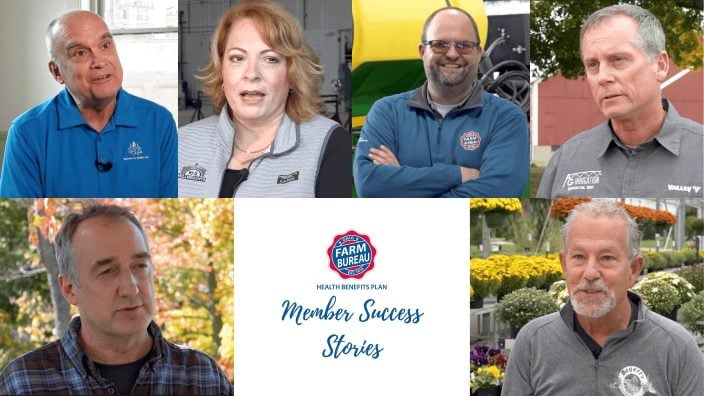Farmer’s Guide to Trucking Regulations available to Ohio Farm Bureau members
The guide includes a farm driver checklist, overview of state and federal regulations and exemptions, CDL qualifications and more.
Read More
It is almost that time of year where we pause for a moment to give thanks for everything that we have been blessed with in the previous year.
This is then followed by the busiest day of shopping in which we buy more gifts for family and friends, but that is a whole different story. I want to focus on the role that farmers play in one of our most food focused holidays.
The National Turkey Federation surveyed the 88 percent of Americans who claimed that they would be eating turkey on Thanksgiving. This equates to 46 million turkeys being eaten at Thanksgiving. This number far exceeds the amount of turkeys eaten at other holidays, such as the 22 million turkeys on Christmas or the 19 million turkeys devoured on Easter.
This huge call for turkeys helps to employ 20,000 to 25,000 people in the raising, butchering and exporting of turkeys.
Yet turkeys are not the only Thanksgiving staple that is important to the economy or provided by farmers.
That delicious sweet potato casserole covered in gooey marshmallows comes straight from the field to your dinner table.
Sweet potatoes or yams have a long history here in the United States. Native Americans, who also hunted the wild turkey for its sweet meat, cultivated sweet potatoes. Like many other things from the New World, the Europeans took the sweet potato back with them to Europe where their popularity grew.
According to the U.S. Census Bureau, 98,300 acres of U.S. farmland were planted with sweet potatoes. This new research has allowed sweet potatoes to become resistant to insects and diseases. Louisiana grows almost 20.3 percent of the sweet potatoes in the U.S. and these tubers contributed over $151 million dollars to the state economy in 2003.
Next comes the stuffing, a component of which is bread, leading us to discuss wheat production in the U.S. Wheat has been around for more than 17,000 years but was more like wild grass. Its origin can be traced to the “cradle of civilization” in the Tigris and Euphrates River Valley in the area that is now Iraq.
Wheat made its first appearance as a hobby crop in the United States in 1777 and today it is the primary grain in most grain products produced in the nation. There are six classifications of wheat, which include hard red winter, hard red spring, soft red winter, hard white, soft white and durum.
In 2008, U.S. farmers grew 2.4 billion bushels of wheat on 63 million acres of land. Kansas is the largest producer of wheat, followed closely by North Dakota. One bushel of wheat is equal to approximately 60 pounds and can be made into 42 pounds of white flour or 60 pounds of whole wheat flour.
Finally, comes the pumpkin pie that is the crowning glory of the Thanksgiving table. While you may still have your pumpkins left over from Halloween, those are not the types of pumpkins that you want to use in your pie. You want to find yourself a sugar pumpkin.
Similar to wheat, pumpkins have been grown in the United States for more than 5,000 years, and there are four different types of pumpkins.
Pumpkins have a high nutritional value and are a seasonal product that appears in markets from October to January. The number one state that grows pumpkins is Illinois, which produces almost 80 percent of all pumpkins. The majority, 100,000 tons of pumpkins commercially produced, become canned pumpkin.
In 2012, Ohio was the fourth-largest producer of fresh pumpkins.
Most pumpkins are orange due to their high level of beta-carotene. However, scientists are attempting to create red, white, grayish-blue and green pumpkins for both looks and health benefits.
So when you sit down to dinner next Thursday, make sure to say a small thank to the farmers who worked and still work tirelessly, ceaselessly and continuously to provide food for us to enjoy. Even as we sit down to enjoy this delicious meal, followed by an afternoon of napping, football and family time, a farmer is probably heading back out to his fields, animals or machinery, getting ready to tackle another day so we can prepare a magical feast for Christmas.
Submitted by Christen Clemson, a member of the Trumbull County Farm Bureau who has completed her doctorate at the Pennsylvania State University. She and her family farm in Mecca Township.
OFBF Mission: Working together for Ohio farmers to advance agriculture and strengthen our communities.


The guide includes a farm driver checklist, overview of state and federal regulations and exemptions, CDL qualifications and more.
Read More


ODA will enroll 500,000 acres into the program for a two-week sign-up period, beginning April 22, 2024, through May 6, 2024. Contact local SWCD offices to apply.
Read More

Katie Share of Columbus has been named ExploreAg and Youth Development Specialist for Ohio Farm Bureau.
Read More

Mary Klopfenstein of Delphos has been named Young Ag Professional and Ag Literacy Program Specialist for Ohio Farm Bureau.
Read More

The plan has been updated to give sole proprietors access to more rate stability and a smart solution that offers potential savings on health care.
Read More

The American Farm Bureau Federation, in partnership with Farm Credit, is seeking entrepreneurs to apply online by June 15 for the 2025 Farm Bureau Ag Innovation Challenge.
Read More

Adele Flynn of Wellington has been elected treasurer of the Ohio Farm Bureau Federation and now holds the third highest elected office in Ohio’s largest and most influential farm organization.
Read More

Producers are urged to work with their veterinarian to practice enhanced biosecurity measures and review and limit cattle movements within production systems.
Read More

The changing seasons bring with them the need to thoroughly inspect pole barns for any damages that may have occurred during the winter months.
Read More

Hundreds of Ohio businesses and sole proprietors are raving about Ohio Farm Bureau’s Health Benefits plan with lower, predictable costs and easy enrollment and administration options.
Read More